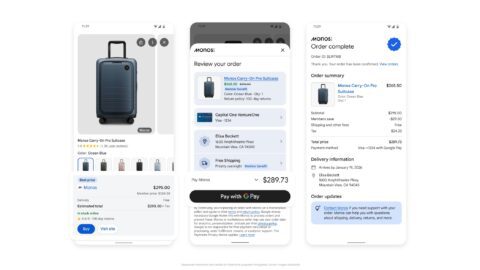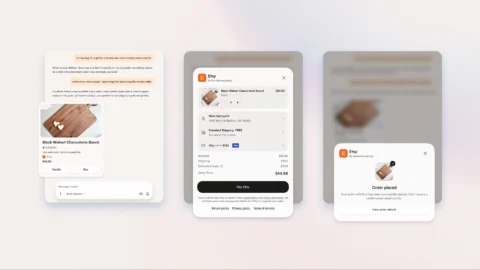Part II of a two-part series discussing the browsing and buying preferences of the mobile consumer. Part I appeared in the February 21 newsletter.
Mobile technology has become an integral part of the browsing and buying journey. Shoppers are tapping into their smartphones at home, in store aisles, and on-the-go to explore possible purchases, compare prices at different locations, and retrieve special offers and coupons.
Best-in-class retailers are responding by building relationships with shoppers via smartphone devices to create more memorable and interactive brand experiences. By sending personalized messages via SMS and push notifications, based on consumers’ browsing and buying behaviors, retailers are able to incentivize customers with targeted offers.
Findings from a recent report titled “Prosper Mobile Insights Mobile Survey” indicated that mobile usage will continue to soar throughout 2012. Nearly half (44%) of consumers resolved to spend more time using their smartphone/tablet device during the year. Overall, mobile subscribers claim they will use their devices more frequently to shop (27%) and complete payments (25%). As mobilized consumers continue to evolve, today’s merchant is presented with an optimal channel to engage these tech-savvy shoppers.
Research from InsightExpress also spotlights the increase in mobilized, multi-tasking shoppers. The “4Q2011 Digital Consumer Portrait” indicated that 33% of smartphone owners use their phones for at least six activities. These mobile subscribers are characterized as “heavy smartphone users.”
Top tasks for which heavy smartphone subscribers use their devices include:
- Text friends and family (87%);
- Access email (79%);
- Browse the Internet (76%);
- Update social networking accounts (59%); and
- Use Apps (55%).
Retailers can leverage all these areas of the mobile experience to initiate conversations with shoppers and foster greater loyalty. Before deciding on a mobile strategy, however, marketers must have a firm understanding of their target audience, including age and overall shopping preferences. For example, among heavy smartphone users, 58% are between 18 and 29 years old, according to InsightExpress research. As smartphones features become easier to manage, consumers across age segments are growing more eager and willing to participate in mobile activities.
“For today’s consumers, what used to be a text is now a Facebook status update or store check-in, and what once was a phone call to a business is now a site visit,” said Dan Lowden, VP of Marketing for Digby. “Mobile is completely transforming personal means of communication and centering it around the smartphone. More ‘mobile shoppers’ and ‘every day’ shoppers are using mobile across all channels. As a result, retailers need to prepare for and embrace this new paradigm.”
The Great Disconnect: Retail Mobile Implementations Fall Behind
Although most retailers recognize the arrival of the “mobile revolution,” overall implementation rates are not keeping pace with smartphone usage. In fact, average retailers are struggling to match the connected consumers’ growing demand for information and purchasing capabilities via smartphones.
A recent retailer survey from RSR Research, titled “Keeping Up with the Mobile Consumer,” indicated that although retailers are aware of mobile’s importance in boosting customer loyalty and ROI, overall implementation is lagging.
Key findings regarding sentiment vs. actual implementation are as follows:
- 83% of retailers said a search-for-merchandise capability is vital to a mobile strategy (versus 35% who have implemented);
- 76% believe store locator features are very important (versus 48%);
- 63% indicated the ability to receive coupons/offers is important for mobilized shopper (versus 32%);
- 61% of respondents think providing access to product reviews is key (versus 26%);
- 55% believe “check order status” features are vital for an optimal mobile experience (versus 25%);
- 54% think providing access to product ratings is imperative (versus 31%); and
- 53% said it is important to provide tech-savvy shoppers with the ability to redeem coupons and offers via their mobile device (versus 29% who have implemented).
The array of mobile strategies and tools currently available presents a low-hanging fruit opportunity for retailers. For example, some merchants are using signage that incorporates scannable tags to create a more interactive in-store experience, according to Dianne Kremer, Senior Analyst for BIGinsight.
“Interactive displays/shelf tags and store-specific apps help engage mobile savvy shoppers in-store,” Kremer told Retail TouchPoints. “About one-third of mobile shoppers have read product reviews and scanned QR codes to get more information about a product while shopping in-store; we can only expect this number to grow as more products/retailers incorporate mobile technologies in their marketing plans. The recent survey from Prosper Mobile Insights shows that mobile shoppers like quick, interactive apps that improve their shopping experience.”
Industry experts also point to the emergence of HTML5, which allows companies to create an engaging and agile mobile web experience to complement their applications, according to Nick Taylor, CEO of Usablenet, a mobile and multichannel platform company.
“In 2012, we expect to see more retailers deploy comprehensive mobile strategies that include both next-generation HTML5 technologies to implement faster and more agile mobile sites, while complementing their mobile browser presence with native apps to drive increased brand loyalty and in-store interactions,” Taylor reported.
Amazon Contributes To The Growth Of Price Comparison Applications
While the planning and implementation process of mobile marketing strategies continues to be a struggle for many merchants, innovative brands such as Amazon, HauteLook and Starbucks excel in reaching and engaging consumers.
The release of Amazon’s Price Check app has sparked the emergence of price comparison resources that allow shoppers to find the best buy, perhaps elsewhere, while roaming store aisles.
Available for iPhone and iPod Touch, Price Check offers shoppers detailed pricing information for millions of products available through Amazon and its roster of merchant sellers. It allows shoppers to search for items via barcode scanning and by voice, image or text. Once merchandise is located in the Amazon database, shoppers can view price comparisons, product descriptions and reviews. If the app finds several related products, top search results will be displayed, as well as the lowest price available for new items.
“Coordinating the online shopping process into one easy-to-use app and providing the lowest prices on products being considered in-store is a huge strategic advantage for online-only Amazon,” Kremer noted. “Really, any company that has adapted its web site and digital communications to be compatible with smartphone and tablet technologies also is a leap ahead of everyone else.”
However, Amazon’s Price Check app has been characterized as a top threat to retailers, Kremer explained. Developing a mobile-optimized site and messaging strategy is key to combating this and similar price comparison apps. In fact, according to RSR Research, 24% of retailers currently are responding by strategizing their own mobile marketing and commerce initiatives.
HauteLook Boosts Brand Proliferation And Loyalty Via Mobile Marketing
HauteLook also is using mobile as an essential facet of its marketing and branding strategy to create more personal relationships with subscribers. The online-only flash sale retailer relies on push notifications via smartphone and tablets, as well as targeted and timely email messages to drive traffic at the start of every sale.
HauteLook opens new events daily at 8 a.m. PST, providing items in verticals including men’s and women’s fashion and accessories, beauty, children’s apparel, toys, home décor and travel getaways. With a free membership, shoppers receive full access to a curated assortment of goods that are discounted up to 70%.
“Mobile access through smartphones and tablets has become a large part of our business,” Greg Bettinelli, SVP of Marketing for HauteLook, told Retail TouchPoints. “As we continue to grow, we are making it a priority to promote mobile applications that are engaging and easy to navigate.”
In an effort to boost basket size during the 2011 holiday season, HauteLook developed online holiday gift shops that were organized based on a variety of categories, including gender and item type. Ongoing, the retailer strives to connect the dots between its mobile efforts and social media strategy, which relies largely on promoting sales, sharing coupons and encouraging brand enthusiasts to share information with friends and family. The retailer also is taking multiple strides in creating a more personalized experience across channels.
“Most people who follow brands on Facebook and Twitter typically are brand enthusiasts already,” Bettinelli said. “It is vital to deliver messages that encourage them to be ambassadors. It isn’t about selling items on Facebook — it’s about driving incremental behavior through exclusive access to sales, events and information.”
Starbucks Drives Consumer Loyalty Via SMS, QR Codes And Augmented Reality
Since its inception in 1971, Starbucks has been a notable leader in the retail coffee business. In recent years, the Seattle-based company has adapted to reach mobile savvy consumers in a memorable way. During 2011, the company upped the ante on its POS strategy by releasing the Starbucks Card app for iPhone, iPod Touch, Android and BlackBerry. By the end of 2011, the merchant completed 26 million mobile transactions, according to a company statement.
To increase sign-ups for its My Starbucks Rewards program, Starbucks leveraged compelling calls-to-action in stores. A message board strategically placed near the order counter touts the message, “Your next drink could be free,” and includes an SMS short code and keyword. Once consumers opt-in, they are provided with a link to register for the My Starbucks Rewards page.
Recently, Starbucks expanded its mobile presence with interactive marketing strategies including QR codes and augmented reality. During January 2012, the coffee merchant rolled out a QR Code campaign to promote its new line of Blonde, Medium and Dark roasts. In-store signage, bookmark flyers and other print advertisements feature the codes, which provide consumers with in-depth information, including videos, on each roast upon being scanned. Consumer also may vote for their favorite beverage, further boosting interactivity.
Augmented reality is gaining momentum among retailers, and Starbucks is a notable leader in the space. For Valentine’s Day 2012, the company launched its Everylove campaign, which includes real tales of love and devotion from loyal brand fans. This makes Starbucks’ personalization strategy further, and also creates a strong connection between brand fans and the company.
By downloading Starbucks’ Cup Magic app for iPhone or Android, customers can watch their coffee cups come to life with animation. The company launched a similar campaign during the 2011 holiday season, which included animated segments of carolers and a young boy sledding with his dog.
Expectations For 2012 And Beyond…
As merchants continue to test cross-channel marketing strategies, mobile will become an essential asset to engage with shoppers, according to Kremer. Due to the continued proliferation of mobile technology, consumers are browsing, buying and communicating with brands through their smartphones and tablets in droves. In turn, highly interactive marketing strategies, such as geo-couponing, are becoming a necessity, rather than a nice to have.
Although results from the Prosper Mobile Insights survey indicate that a majority of consumers are still wary of geo-location programs and swipe-to-pay offerings, this will quickly shift as retailers fight to dispel privacy concerns, Kremer added. “Just as consumers have become more comfortable with online shopping, it is likely that the privacy and security concerns associated with geo-couponing and mobile payment apps also will start to dissipate in 2012,” she said. Bruce Warren, VP of Marketing for Empathica, a provider of customer engagement management programs, further indicated that with the continued rise in smartphone application usage, consumers will seek more focused, personalized experiences via geo-location-based apps that tie to the store.
“We will see more brands developing their offerings in the area of geo-location apps,” Warren explained. “This is because retailers will need to improve engagement with customers at the store-level to build awareness of their various channels, and actively direct consumers toward the brand’s mobile and desktop sites to emphasize the cross-channel experience. At the same time, retailers must better understand their customers’ behaviors while browsing on mobile devices to target them more effectively with personalized in-store offers.”
Mobile-savvy shoppers also will look to store associates to create an information-rich in-store experience. Through mobile devices and clienteling applications, retailers can optimize line-busting strategies and create a more compelling and personalized experience for each shopper.
“We are seeing more retailers make committed moves to mobile technology — beyond just pilots and experiments,” said Jerry Rightmer, President and CTO of Starmount, an mPOS solution provider. He explained that as shoppers advance beyond the novelty of mobile shopping technology, they will expect in-store sales associates to be mobile-equipped. “Consumers also will expect self-serve tools such as in-store mobile apps and mobile-optimized web sites that provide relevant information as they shop,” Rightmer said.
In the area of mobile payment — which is generating a buzz but has limited implementations to date — more mobile handsets will be equipped with near field communication (NFC) technology and “tap to pay” capabilities. As a result, in-store rollouts of mobile payment solutions will gain momentum throughout 2012.
Jason Goldberg, VP of Strategy and Customer Experience for CrossView, a cross-channel commerce solution provider, also discussed the inevitable growth and takeover of NFC, which can be used to track what products a shopper is standing in front of at any given moment.
“Once mobile payments become ubiquitous and drive new smartphones to support NFC, we’ll start to see in-store marketers use this technology to offer better micro-location-based experiences,” Goldberg said. “Location, payment, and affinity data will merge to paint a clearer picture of a shopper’s path to purchase in a store. Larger retailers that can afford to invest in the latest mobile technologies will get outsized returns.”












